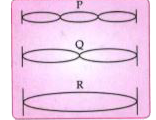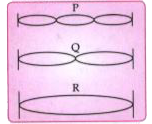(a) Draw diagrams to show the longitudinal mode of vibration and transverse mode of vibration of an electrically maintained tuning fork in the Melde's experiment.
(b) Indicate with the help of a diagram the positions of nodes and antinodes on a vibrating tuning fork.
Step-by-Step Solution
1. Longitudinal Mode of Vibration:
- In the longitudinal mode, the particles of the medium move parallel to the direction of the wave propagation.
- Draw a straight horizontal line to represent the tuning fork.
- Indicate compressions (areas where particles are close together) and rarefactions (areas where particles are spread apart) along the line.
- Label the compressions as "C" and the rarefactions as "R".
Diagram:
CRCRC⊢−⊢−⊢−⊢−⊢−∣(Tun∈gFork)
2. Transverse Mode of Vibration:
- In the transverse mode, the particles of the medium move perpendicular to the direction of wave propagation.
- Draw a horizontal line representing the tuning fork.
- Show the displacement of particles above and below the line to indicate crests and troughs.
- Label the crests as "T" (for Trough) and the troughs as "C" (for Crest).
Diagram:
TT // −−−−−−−−−−−−−−−−−(Tun∈gFork) / /CC
Part (b): Positions of Nodes and Antinodes on a Vibrating Tuning Fork
1. Identify Nodes and Antinodes:
- Nodes are points where there is no displacement (the medium does not move), and antinodes are points where the displacement is maximum.
- Draw a horizontal line to represent the tuning fork.
- Mark the nodes as "N" and the antinodes as "A".
Diagram:
AAA|||NNN|||−−−−−−−−−−−−−−−−−(Tun∈gFork)
- In the longitudinal mode, the particles of the medium move parallel to the direction of the wave propagation.
- Draw a straight horizontal line to represent the tuning fork.
- Indicate compressions (areas where particles are close together) and rarefactions (areas where particles are spread apart) along the line.
- Label the compressions as "C" and the rarefactions as "R".
CRCRC⊢−⊢−⊢−⊢−⊢−∣(Tun∈gFork)
- In the transverse mode, the particles of the medium move perpendicular to the direction of wave propagation.
- Draw a horizontal line representing the tuning fork.
- Show the displacement of particles above and below the line to indicate crests and troughs.
- Label the crests as "T" (for Trough) and the troughs as "C" (for Crest).
TT // −−−−−−−−−−−−−−−−−(Tun∈gFork) / /CC
- Nodes are points where there is no displacement (the medium does not move), and antinodes are points where the displacement is maximum.
- Draw a horizontal line to represent the tuning fork.
- Mark the nodes as "N" and the antinodes as "A".
AAA|||NNN|||−−−−−−−−−−−−−−−−−(Tun∈gFork)
Topper's Solved these Questions
- BOOK - ICSECHAPTER - WAVESEXERCISE - Short Answer Questions.32videos
WAVES
- BOOK - ICSECHAPTER - WAVESEXERCISE - Superposition Of Waves, Beats, Stationary Waves55videos
WAVES
- BOOK - ICSECHAPTER - WAVESEXERCISE - Conceptual Short Answer Questions With Answers25videos
WAVES
- BOOK - ICSECHAPTER - VECTORS SCALARS ELEMENTARY CALCULUS EXERCISE - UNSOLVED PROBLEMS79videos
VECTORS SCALARS ELEMENTARY CALCULUS
Similar Questions
Draw a diagram to show the various modes of vibration of a stretched string.
View SolutionDraw diagrams to show the loop formation in a vibrating tuning fork.
View SolutionDraw diagrams to show the various modes of vibration in (i) an open pipe and (ii) a closed pipe.
View SolutionUsing suitable diagram explain how sound wave propagates through air from a vibrating tuning fork?
View SolutionThe diagram below shows three different modes of vibration P, Q and R of the same string of a given length.

What is the ratio of the wavelength of vibrations P and R?View SolutionThe adjacent diagram shows three different modes of vibrations P, Q and R of the same string.

State the ratio of wavelengths of P and R.View SolutionThe adjacent diagram shows three different modes of vibrations P, Q and R of the same string.

Which vibration will produce a louder sound and why?View SolutionThe diagram below shows three different modes of vibration P, Q and R of the same string of a given length.

Which vibration will produce a louder sound and why?View SolutionIn the figure given alongside, mark compressions and rarefactions of a wave as the tuning fork is vibrating. Also mark one complete wave.
 View Solution
View SolutionThe diagram below shows three different modes of vibration P, Q and R of the same string of a given length.

Which vibration will produce a sound of maximum shrillness (or pitch) and why?View Solution

